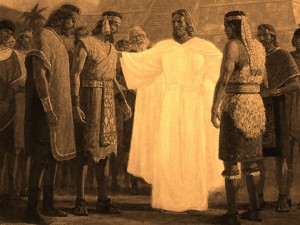Here’s the introduction to this series; briefly put, it is looking at the original ‘chapter’ divisions in the Book of Mormon manuscripts (original and printer’s, resulting in the 1830 first edition). As noted in the introduction, it appears from original manuscript evidence that these chapter divisions were somehow indicated on the plates themselves and thus would represent editorial decisions by the author, in this case, Nephi1 (whom I’ll just refer to as “Nephi” hereafter). All my chapter-and-verse citations will use the modern edition, and I’ll link to the LDS Church’s on-line edition; however, when I quote text directly, I will quote from The Book of Mormon: The Earliest Text (Royal Skousen, editor, Yale University Press, 2009), following Skousen’s layout.
For reference, here is a chart comparing the 1830 chapters to the modern edition chapters.
First Nephi (modern edition: 1 Nephi)
First, a bit of context. Nephi started working on what we now refer to as “the small plates of Nephi” (First and Second Nephi; the plates would eventually contain Jacob, Enos, and Omni as well) thirty or more years after leaving Jerusalem and finished his historical portion sometime within a ten-year period (2 Nephi 5:28-34). By the time he started the plates, he and his followers had fled from Laman and Lemuel, leaving the original Lehite settlement and relocating to what would become known as “the land of Nephi”. When he left, Nephi took with him the brass plates, the director ( “liahona”, though that name is only used once in the Book of Mormon itself and then only several centuries after the time of Nephi), and the sword of Laban (2 Nephi 5:12-14). I suspect it was the theft of these key items — the only tangible links back to Jerusalem as well as objects with substantial religious/totemic value — that infuriated Laman and Lemuel enough to lead them to track down and attack Nephi and his people, though they may also have seen Nephi as a lingering threat to their own legitimacy as rulers over their own people. (Centuries later, we still see Lamanites bitterly complaining about how Nephi robbed Laman and Lemuel not just of physical items but also of “their right to the government“.)
The flight into the wilderness and the initial wars with Laman and his people all happen (2 Nephi 5:1-27) before Nephi creates and starts writing the small plates, the ones that contain “the things of my soul“. Up until now, he has been adding to his father’s record (the lost “Book of Lehi“), but under divine direction he creates a record entirely of his own. He gives it the title, “The Book of Nephi, His Reign and Ministry” (hereafter “First Nephi”), which indicates what he thinks he will be writing about, at least eventually; as it turns out, he writes very little about his ‘reign’, and all that will be saved for the second “Book of Nephi”. And unless you include his (truly remarkable) visions and prophecies, this book doesn’t have much in the way of ‘ministry’ either — mostly just lectures to and arguments with his brothers.
Nephi also lays out what he intends to cover in this book; in essence, an outline or table of contents, but one clearly devised ahead of time, not just because of its location on the plates (at the start of First Nephi), but because of all that it leaves out. While this introduction does clearly sketch out the historical sequence covered by First Nephi and in that order, it completely leaves out those remarkable visions and prophecies alluded to earlier, and the structure of what Nephi actually wrote doesn’t mesh exactly with his planned contents. Here is Nephi’s introduction (after Skousen) as aligned with the actual chapters in First Nephi:
An account of Lehi and his wife Sariah and his four sons,
being called, beginning at the eldest,
Laman, Lemuel, Sam, and Nephi.[Chapter I]
The Lord warns Lehi to depart out of the land of Jerusalem
because he prophesieth unto the people concerning their iniquity
and they seek to destroy his life.He taketh three days’ journey into the wilderness with his family.
Nephi taketh his brethren and returneth to the land of Jerusalem
after the record of the Jews.The account of their sufferings.
[Chapter II]
They take the daughters of Ishmael to wife.
[Chapter III]
[Chapter IV]
[Chapter V]
They take their families and depart into the wilderness.
Their sufferings and afflictions in the wilderness.
The course of their travels.
They come to the large waters.
Nephi’s brethren rebel against him.
He confoundeth them, and buildeth a ship.
They call the name of the place Bountiful.
They cross the large waters into the promised land etc.
[Chapter VI]
[Chapter VII]
This is according to the account of Nephi,
or in other words, I, Nephi, wrote this record.
In short, it is clear I think that Nephi started out with an(other) historical record in mind — his “reign and ministry”, with the events that led him to that point. As is often the case for writers, however, what he started out to write is not what he wrote at the end. Likewise, a record that starts on a rather triumphal note (again, “reign and ministry”) diverts into harsh self-recrimination (2 Nephi 4:17-35) just before a very short recounting of his actual reign and ministry (2 Nephi 5:1-28) and an abrupt end to his historical record (the rest of Second Nephi is prophecy and scripture).
Next post: First Nephi I (1 Nephi 1-5). ..bruce..
